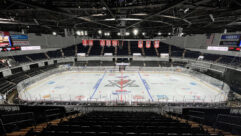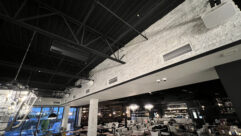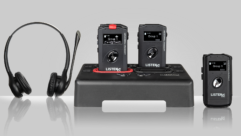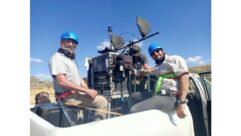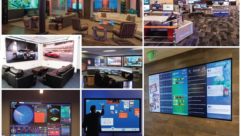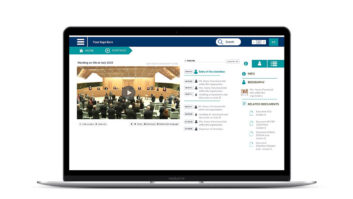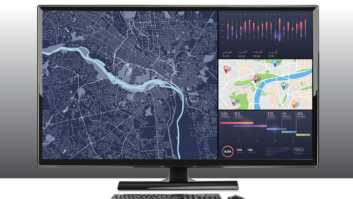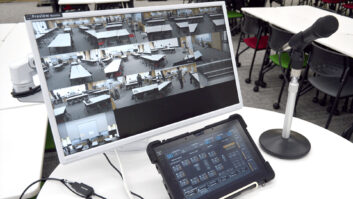Southern Versatility
Dec 1, 2002 12:00 PM,
By Lawrence Graham and Bradley Weber
Live stage performances almost always need some kind of sound system. Those systems can range from relatively simple speech reinforcement systems to complicated performance, sound effects, and production systems. They also range from completely portable systems to permanently installed systems. For theater facilities intended to house resident companies, the most important sound-system qualities are versatility and permanence. That is true for the recently opened John S. Burd Center for the Performing Arts at Brenau University, a private university in Gainesville, Georgia.
Brenau University has a long-standing reputation for educational excellence in the performing and fine arts. The campus plays host to a wide variety of theatrical and musical events. In addition, the university forms an integral part of the Gainesville Theatre Alliance, a theatrical production agency that includes Brenau University, Gainesville College, and Theatre Wings, a volunteer community support group serving the northeast Georgia community. Working together, those groups produce high-quality stage productions that are presented in several performance venues in the Gainesville area.
The John S. Burd Center for the Performing Arts was envisioned as expanding on and supplementing the overloaded and deteriorating performance and arts education facilities at Brenau University. In the new center, the primary performance space is the Hosch Theater. The Hosch Theater is meant to be a jewel-box music theater — intimate and relatively small in seating capacity (350) but equipped with high-quality and versatile technical sound equipment. In addition to the Hosch Theater and the related back-of-house facilities, the Burd Center also houses numerous other spaces, including a rehearsal theater, a recital hall used as a multipurpose space, a choral rehearsal space, student music practice rooms, teaching studios, a lecture hall, and an art gallery.
In order to support both resident performance groups and the other uses of the Burd Center, the technical program called for integrated audio systems that would provide various features depending on the needs of the space (see the sidebar “Going Versatile”). Several factors and considerations went into designing the sound systems and selecting the audio equipment for this kind of comprehensive performance and education facility.
VOCAL AND MUSIC SPEAKER SYSTEMS
The Hosch Theater is primarily intended to be a music performance space, where choral performances, musical plays, and operettas will be presented. This kind of traditional music performance relies mostly on trained voices and instruments using the natural acoustical properties of an audience chamber to make electronic reinforcement unnecessary. However lofty the objective of natural acoustical reinforcement may be, the Hosch Theater, like most educational institutional theaters, must deal with performers still in training, as well as less-than-ideal instrumentation mixes. Therefore, in order to support those situations, electronic reinforcement is required.
There are two objectives that are often the most difficult to achieve in the audio reproduction of live musical play performances. The first is balancing the live sound of the orchestra or other musical accompaniment in the orchestra pit or onstage against the live sound of the singer(s) on the stage. When a novice singer tries to sing over a full orchestra, vocal reinforcement is often necessary. Nevertheless, the audio-reinforcement system should attempt to retain the illusion that only the unassisted voice is being heard. That kind of aural illusion is typically achieved onstage by wireless microphones hidden in wigs or costumes.
To maintain the illusion, the performance space must couple the stage trickery with a carefully designed speaker and processing system. That means that to maintain the illusion of only the natural voice and acoustical environment, the speakers and other devices that form the electronic reinforcement system must be visually unobtrusive, be positioned and selected to localize sound to the performer’s location on the stage, minimize changes to the natural sound quality, and work with the natural room acoustics. Even with careful design, this kind of system can accomplish the proper illusion only when used with subtlety.
For the Hosch Theater to accomplish those objectives, a left/center/right arrangement was used for the main house speaker system. This arrangement uses three speaker assemblies located at left, center, and right stage positions, which allows the audio image to be more precisely and accurately placed. For example, with center stage sounds reproduced through an actual center speaker cluster rather than emulated by a virtual phantom center speaker as in typical stereo systems, a more realistic and accurate audio localization cue is achieved. In order to minimize the visual impact, the speakers were integrated into architectural openings in the ceiling reflectors and front wall.
In addition, two primary objectives were established for the speaker systems. The first objective was to have wide frequency response and adequate output to support the musical portion of performances. The second objective was to provide pattern control that resulted in good coverage of the seating area while minimizing spill onto the walls and ceiling. The walls and ceiling were fairly live, providing a natural acoustical reinforcement appropriate for this type of space. Because physical constraints limited the size of the speaker cabinets that could be installed, two compact JBL SP212-6 two-way speakers were installed at each of the three cluster locations. One JBL SP125S subwoofer was located in the box boom area on each side of the house to provide extended low-frequency reproduction. The speakers are powered by one Crown CT-1610 per cluster, one channel per speaker. The subwoofers are powered by a fourth CT-1610. A Crown IQ-USM 810 provides signal routing and speaker processing for the house speakers, under balcony fill speakers, lobby ceiling speakers, and gallery ceiling speakers.
LIVE-PERFORMANCE MONITORING
The second difficult issue in the audio reproduction of live performances is keeping the orchestra, which is located in the pit, and the singers, who are onstage, together in terms of tempo and pitch. Both depend, at least in part, on audio monitoring. Although the singers are presumed to be watching the conductor’s baton, stage movement may preclude their ability to do that for several measures at a time. When that occurs, the singers can rely only on audible cues.
Some performances also make use of offstage choruses, which rely heavily on some type of sound monitoring. When ensembles are singing onstage, it is not unusual, even in the best of halls, for the sound produced to mask any sound coming from the orchestra pit. When that happens, remaining on pitch becomes virtually impossible.
Those problems can be solved by providing a way to monitor the orchestra pit sound at the stage level. If, however, the orchestra pit sound is picked up by the stage microphones and amplified, balancing the singers against the live orchestra sound can become problematic. That is particularly true when the effect of an unamplified performance is the ultimate objective. In addition, it may be necessary to provide sound monitors in the orchestra pit for those occasions when actors must hear stage sound to produce coordinated musical sound for the audience.
To address these issues, the Hosch Theater was provided with two methods of monitoring sound. Four Yamaha XM4220, 4-channel amplifiers connected to the house mixing system through patch bays feed 15 dedicated monitor receptacles around the stage and orchestra lift. An additional Yamaha XM6150, 6-channel amplifier feeds four more monitor receptacles in the orchestra pit. To supplement this dedicated monitoring system, there are 39 line-level tie-lines from patch bays at the mix position to receptacles located throughout the stage area and orchestra pit. Those can be used to feed powered monitors if supplemental monitoring is required.
LIVE SOUND MIX
When vocal and musical reinforcement are required, a live sound mix capability is essential. This mix capability is critical not only in creating the proper localization and spatial cues but also in providing the control, routing, and distribution required to support myriad support and ancillary audio signals for recording, vocal effects, and assistive-listening-system feeds. To properly mix a performance, it is essential that the mixing console operator be able to hear what the audience is hearing, thereby allowing the console operator to adjust the mix and related electronics accordingly. However, the very idea of creating the illusion of having no electronic audio reinforcement can be destroyed by placing an obvious sound controller in the middle of the audience space. When the room’s natural acoustics are considered, it is sometimes possible to place the mix board in a more discrete location and still obtain optimum results.
That was the approach used in the Hosch Theater. A mix position that was almost totally open to the performance space was incorporated at the rear of the theater, behind and above the balcony seating. Because of the theater’s shallow depth and high ceiling, the mix position is in the natural acoustical environment of the audience space.
A Crest X-Eight HS console with 32 mono inputs and 4 stereo inputs provides the performance mixing capability. Fifty-two mic input receptacles are located at the stage, orchestra lift, and orchestra pit. Those microphone inputs, along with three Audio-Technica ES933/ML hanging microphones and four Shure U-series wireless body-pack microphone systems, are available as inputs to the mixing console through ADC BJF203-4MKIVSN patch bays. The patch bays are wired with the most common microphone inputs normaled to the Crest console’s inputs. In addition to the microphone inputs, a Denon DN-C360 CD player, a Sony MDS-E12 MiniDisc recorder, a Marantz PMD-502 audio cassette recorder, and the sound-card output from the digital audio workstation (DAW) are patched to the mixing console as stereo inputs. All mixing-console line inputs and outputs are wired to ADC BJF303-4MKIV patch bays.
The main outputs are normaled to the IQ-USM 810 main speaker processor, the matrix outputs to the lobby and art gallery speaker systems and to the fixed upstage effects speaker and recording mixer, and the group outputs and some of the auxiliary outputs to the monitor feeds. The other auxiliary outputs are available to the vocal effects devices. The permanent effects complement includes a Lexicon MPX500 dual-channel digital effects processor and two 565E dual compressor/limiter/expanders from Symetrix. The assistive-listening output is normaled to the Listen Technologies LT-800 ALS RF transmitter and the program input of the Clear-Com 2-channel production communications system MS-232 main station.
SOUND EFFECTS
Sound effects for stage production may be reproduced from a recording or created live. Generally, live reproduction of sound effects is limited by what is practical. Gunshots or ringing doorbells may easily be created from behind the scenery. However, explosions, vehicle noises, and most environmental sounds are not as readily reproduced live for a larger audience. Physical constraints and control of certain aspects of the sound effects such as duration and volume can be impractical. It is that second category of sound effects that requires a way of creating, editing, and reproducing the effects electronically.
Sound effects design is a separate production department, which — just like scenery, lighting, and costume design — requires skill and specialized equipment. Most electronic sound effects are produced prior to any performance in dedicated production facilities. These effects may come from a variety of sources but must be combined into a series of cues that can be instantly integrated into the live action of the performance. Because more than one cue may be operating independently at the same time, this requires playback devices that can access and play these prerecorded cues quickly and accurately.
Also critical in achieving the desired result of any sound effect is the ability to reproduce the effects in a realistic manner in the performance space. Sound effects playback can be an important part of the overall theatrical illusion. However, the effects must fit seamlessly into the rest of the production. Generally, sound effects fall into two categories — atmospherics and specific effects. Atmospherics are the background sounds that make a particular locale come to life aurally. For example, the sound of rain falling gently outside, the wind on a stormy night, or harbor sounds in the distance all fall into the atmospherics category.
The sounds are generally nondirectional in character, and they become a background for dialogue and may fade in and out in volume as required for the dramatic moments in which they are heard. On the other hand, some effects are intended to call attention to themselves. These may be nondirectional, such as distant thunder, or they may be specifically directional, such as sound from an intercom or a television set. It is not possible for a sound-system designer to know with any certainty where or what kinds of sounds will be required for future productions in the facility. The designer must rely solely on his or her own theater sound experience to provide the most flexible system possible to cope with unknown and variable future performance demands. The sound effects system must therefore provide the ability to reproduce a wide variety of sounds that can realistically reproduce the environmental cues intended by the performance’s sound designer.
For the Hosch Theater, simplicity and flexibility were high on the priority list when designing the sound effects components of the audio systems. A dedicated space adjacent to the mix position in the theater houses a DAW consisting of a Dell PC, a Turtle Beach Santa Cruz sound card, and Stage Research SFX software that can be used to record and edit sound effects. The DAW is fed through the ADC patch bays to the theater mixing console’s stereo inputs and alt stereo output.
A single EAW MK5164 speaker fed from a matrix output through the IQ-USM 810 and one channel of a CT-1610 amplifier is mounted on the back or upstage wall of the stage as a permanent effects speaker. The speaker is used for many of the effects intended to come from the general stage or set areas. To allow for the greatest flexibility in locating other effects speakers, 11 effects speaker receptacles are located throughout the house, in the balcony, and at the lighting gallery. These receptacles are fed from the ADC patch bays and are powered by the two remaining channels of the MX6150 used for monitoring and two additional Yamaha XM6150 amps.
Due to a thoughtful sound system design process and careful equipment selection, the Hosch Theater’s integrated audio systems avoid many of the problems common to facilities like Brenau University’s new John S. Burd Center for the Performing Arts. This dedication and care let the theater support the complex and varied performances that were part of its original goals.
Lawrence Graham, A.S.T.C., is a senior consultant at CDAI with more than 40 years experience in theater design, consulting, and project management. Bradley Weber, P.E., is a senior consultant at CDAI with more than 18 years of audio and audiovisual systems design and integration experience.
Going Versatile
The John S. Burd Center for the Performing Arts at Brenau University required a combination of careful sound-system design and appropriate gear. For the Hosch Theater, the center’s primary performance space, the designers had to meet the following requirements:
- vocal reinforcement for live stage performances, including choral performances;
- reinforcement for live music performances, including musicals;
- flexible sound mixing and routing for performances;
- the ability to support basic lectures and classes without a mixing console operator;
- audio monitoring for the dressing rooms, stage, and orchestra pit, each with its own mix;
- sound effects, including simultaneous effects from more than one source;
- digital-audio recording, production, editing, and playback;
- multiple channel production communications (intercom);
- digital and analog stereo audio recording;
- overflow audio to the lobby and gallery.
The Rehearsal Theater had a much smaller set of requirements, which included digital-audio recording of rehearsals and performances and playback of audio recordings or monitoring of other audio sources using portable powered speakers.
The recital hall and choral rehearsal space had to offer digital-audio recording of rehearsals and performances, playback of audio recordings or monitoring of other audio sources using portable powered speakers, and ties to the production communication system.
For More Information
ADC
www.adc.com
␣ 201
Audio-Technica
www.audio-technica.com
␣ 202
Clear-Com
www.clear-com.com
␣ 203
Crest
www.crestaudio.com
␣ 204
Crown
www.crownaudio.com
␣ 205
Dell
www.dell.com
␣ 206
Denon
www.denon.com
␣ 207
EAW
www.eaw.com
␣ 208
JBL
www.jbl.com
␣ 209
Lexicon
www.lexicon.com
␣ 210
Listen Technologies
www.listentech.com
␣ 211
Marantz
www.marantz.co.jp
␣ 212
Shure
www.shure.com
␣ 213
Sony
www.sony.com
␣ 214
Stage Research
www.stageresearch.com
␣ 215
Symetrix
www.symetrixaudio.com
␣ 216
Turtle Beach
www.turtlebeach.com
␣ 217
Yamaha
www.yamaha.com
␣ 218
␣ Circle this number on Reader Service Card or visit freeproductinfo.net/svc


